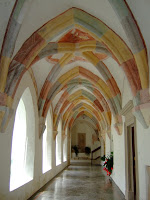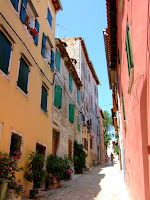
Words cannot do justice to the Church of the Holy Trinity at Hrastovlje. Completely enclosed in high, stone, walls to provide protection from the Ottoman Turks, this tiny church has a Tardis-like quality in that it seems much bigger inside than out.
Almost every internal surface is covered with frescoes from 1490,

a wall-to-wall, Gothic picture-book paupers’ Bible. These frescoes in lichen and red-wine pigments survived under layers of whitewash until the 1950s. There are cartoons of the Creation and the Passion; an Adoration of the Magi; pictures of the Apostles; the Annunciation; and a calendar of monthly tasks. But the showstopper is the Dance Macabre.

This fresco, running the full length of one wall shows Death (skeletons) leading a 15th century pecking order of pope, king,

queen, cardinal, bishop, monk, doctor, moneylender, soldier, cripple and baby to confront their mortality in a stark reminder that before God we are all equal and there will be no A-list celebrity preferences when we die. This is further emphasized by the moneylender who is offering his accompanying skeleton money, in an attempt to alter his destiny.
The guidebook was absolutely correct: “The church is, quite simply a gem: as tiny as a matchbox, as atmospheric as a cathedral.”
Not quite so accurately described is Vipava, dubbed the

“Slovene Venice” as it is built around the springs which form the delta source of the Vipava River and, consequently, it has numerous bridges. However, any Venetian allusions are entirely in the minds of the PR and marketing writers! Nevertheless we explored the different springs that give the Vipava River it’s claim to fame as the only European river that begins with a delta.

The nearby, protected, town of Goče really is worth a detour. The scrape marks on the walls of the narrow streets bear testimony to the narrowness of the streets and alleyways. It looks as though progress has entirely passed it by, leaving it with a timeless Mediterranean feel.

While there, a milk tanker came to collect the milk stored in a vat by the town square. The vat was possibly 200 litres, a far cry from the size of the vats NZ farmers store milk in while waiting for the tanker collection.
However, NZ cannot compete in the castle stakes:

Predjama Castle is big and impressive, built into a natural cave and with an interesting history of withstanding sieges. One besieged occupant discovered a “back door” through the limestone caverns and taunted his enemies by presenting them with roast bullock and freshly picked cherries during the year-long siege. His downfall was a treacherous servant who colluded with the enemy.

En-route to our final destination, we detoured through the Rakov Škojan Regional Park, and did a short walk to a natural limestone bridge. The word karst, referring to the remarkable surface and underground forms, created as a result of the action of water on permeable limestone comes from the Karst area of Slovenia, so this is the ‘home’ of caves, dripstone formations, natural bridges and sinkholes.

One natural phenomenon, in this area, which ‘sinks’ is Lake Cerknica: depending on the time of year and recent rainfall, this area can be a lake, a wetland or pasture; we saw it at the wetland stage.
Being Saturday, we decided to look for accommodation earlier than usual. A nearby ‘Tourist Farm’ provided bed, breakfast and, for a small extra charge, home cooked dinner, so we decided on another new experience.

The village was intriguing: quite different architecture to what we had seen previously. The houses were long and thin, close together along the road and each house had, attached at the rear, a barn with the animals.

Next Slovenian impression: impossibly small land-holdings. The farm sizes were 3 to 5 hectares and the fields all seemed to be long and thin strips, a patch-work quilt of land use, with no fences.
 The disadvantage of spending a night in a small, cosy, farmyard is that the animals like to greet the morning early.
The disadvantage of spending a night in a small, cosy, farmyard is that the animals like to greet the morning early. En-route, at Kostanjevica na Krki, we detoured to view a monastery now converted into an art gallery with an impressive array of huge wooden sculptures in grounds outside. The twin pink and white guardhouses (from the days of the Turkish attacks) look like something from Disneyland. We poked our noses through the archway to have a look at one of the largest Renaissance courtyards in Europe, and left.
En-route, at Kostanjevica na Krki, we detoured to view a monastery now converted into an art gallery with an impressive array of huge wooden sculptures in grounds outside. The twin pink and white guardhouses (from the days of the Turkish attacks) look like something from Disneyland. We poked our noses through the archway to have a look at one of the largest Renaissance courtyards in Europe, and left. Another short detour off our route took us to the spa town of Rogaška Slatina where Liszt once played his waltzes in the ballroom of the Grand Hotel.
Another short detour off our route took us to the spa town of Rogaška Slatina where Liszt once played his waltzes in the ballroom of the Grand Hotel. We figured that we had time for one more stop before having to head back west to the airport so drove on to Slovenske Konjice, which the guidebook accurately described as “absurdly twee” with its pastel colours and stream gurgling down the main street, crossed by little toy bridges.
We figured that we had time for one more stop before having to head back west to the airport so drove on to Slovenske Konjice, which the guidebook accurately described as “absurdly twee” with its pastel colours and stream gurgling down the main street, crossed by little toy bridges. On the way, we had to make a stop as we finally saw a stork and nest. Although common in Slovenia we had only seen one other pair and then at a distance.
On the way, we had to make a stop as we finally saw a stork and nest. Although common in Slovenia we had only seen one other pair and then at a distance. Final Slovenian impression: The houses dotted all over the hillsides: they have ranged from ‘Mediterranean’ to ‘Swiss/Austrian’ and what I guess is ‘Slovenian’.
Final Slovenian impression: The houses dotted all over the hillsides: they have ranged from ‘Mediterranean’ to ‘Swiss/Austrian’ and what I guess is ‘Slovenian’.

















































